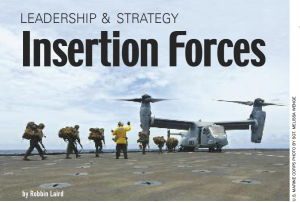2014-10-13 For the United States, the land wars of the past decade led to a significant redirection of its military forces and highlighting key role for the US Army and the USMC playing its ground operations role and to the support of those forces by the US Air Force and the US Navy. A large logistics operation via land, sea, and ground along with significant expenditures to civilian contractors such as Maersk to support the effort was entailed as well.
It has led to a significant bulging of the Department of Defense toward the US Army and its leadership with the other forces largely in a support role.
A major centerpiece of this effort has been Counter Insurgency Operations and the training of local forces to support local governance or a significant role highlighted for national building.
Stability operations were highlighted over traditional conventional operations, and the nuclear dimension of the force structure reduced and largely de-emphasized.
This bulging makes no sense going forward.

The U.S. has insertion forces able to engage and withdraw, and several core allies are shaping similar forces, rather than setting up long-term facilities and providing advisers as targets.
The ability to establish air dominance to empower multi-mission USMC insertion force able to operate effectively, rapidly and withdraw is a core effort that now exists in US way of war for emerging 21st century conflicts.
The classic dichotomy of boots on the ground versus airpower really does not capture the evolving capabilities of either airpower or the evolving capabilities of ground forces capitalizing on those evolving capabilities to provide for more effective and more lethal insertion forces.
2014 with a vengeance has challenged this agenda of the last decade and laid down the grounds for shaping a new one.
An evolving pattern of 21st century conflict is emerging.
It is a pattern in which state and non-state actors are working to reshape the global order in their favor by generating conflicts against the interests of the democracies but which the democracies are slow to react.
In a briefing delivered in Rome on October 3, 2014, Robbin Laird and John Blackburn discussed the challenges of dealing with 21st century conflicts and the approaches being taken by the USMC and the RAAF to dealing with these challenges. The seminar was sponsored by Airpress and held at the Centro Alti Studi per la Difesa (CASD).
The briefing was followed by a presentation by the Italian Chief of Staff of the Air Force, Lt. General Preziosa.
We will publish an interview with Lt. General Preziosa in the near future.
The seminar was highlighted in Il Tempo in an article announcing the seminar published on September 30, 2014.
La Nato e il ruolo di gendarme del XXI secolo
di Michele Pierri, www.airpressonline.it
L’evoluzione dei conflitti militari nel ventunesimo secolo e il ruolo della Nato sono gli argomenti di un seminario a porte chiuse organizzato il 3 ottobre a Roma dalla rivista Airpress presso il Centro alti studi per la difesa.
Speaker saranno il capo di Stato maggiore dell’Aeronautica militare, il generale Pasquale Preziosa, il cofondatore di Seconde line of defense, Robbin Laird e l’Air vice-marshal della Raaf australiana, John Blackburn. Parteciperà al dibattito una platea ristretta composta da diplomatici, think tanker, rappresentanti del mondo accademico, dell’impresa e delle Istituzioni, mentre i lavori saranno introdotti da una relazione scritta “a quattro mani” dai due ospiti stranieri.
Laird è uno dei più autorevoli commentatori americani di fatti della difesa (collabora anche con Defense News e Breaking Defense) ed è autore di numerosi volumi tra i quali il più recente «Rebuilding american military power in the Pacific: A 21st century strategy».
Blackburn invece ha mosso i primi passi della sua lunga carriera nel settore aeronautico come pilota da combattimento, per poi scalare le gerarchie militari del suo Paese. Oggi è consulente per dossier di sicurezza nazionale e membro dell’Australian strategic policy institute council, con il quale lavora a una riorganizzazione della Difesa di Canberra.
L’incontro sarà un’occasione per confrontare differenze e “best practice” nei settori di aerospazio e difesa di Usa, Italia e Australia e per uno scambio sulle strategie internazionali in questi campi fra Alleanza atlantica ed Europa, tanto più dopo il vertice in Galles e alla luce delle scelte che saranno prese in Italia nel Libro Bianco. L’obiettivo è lavorare a un nuovo approccio della sicurezza dell’Occidente e dei suoi alleati che tenga conto dei mutati scenari globali, a cominciare dai maggiori investimenti militari di Paesi ormai non più emergenti.
Il riferimento è al tema del burden sharing e cioè dell’assunzione di responsabilità condivise tra gli Usa e l’Ue nell’ambito delle crisi regionali e delle comuni esigenze di difesa tra le due sponde dell’Atlantico, non ultime quelle relative a programmi strategici, come il caccia di quinta generazione F-35.

